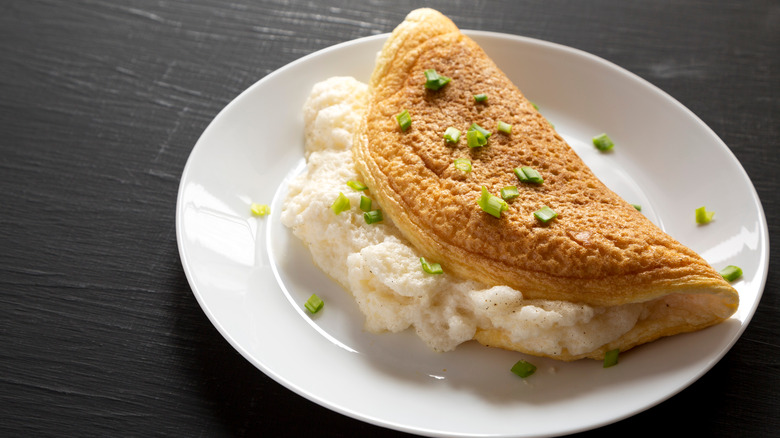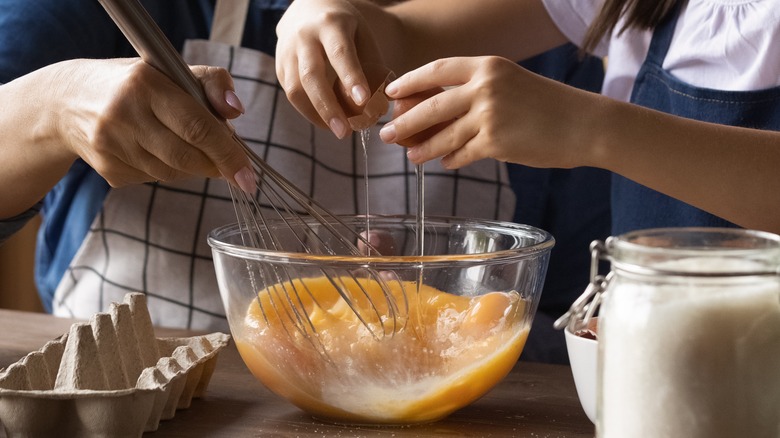What Makes Soufflé Omelets So Unique?
A soufflé omelet is an egg dish that, as its name suggests, is a blend of a soufflé and an omelet. While making an omelet isn't too difficult for most people, the idea of having to whip up a soufflé can be a tad intimidating. But this dish isn't something solely made by the pros. By following a few simple hacks, it's easy for any home cook to achieve and worth trying because they are so delicious. And with fluffiness being such a big part of what makes a soufflé omelet an upgrade on a traditional omelet, it's no surprise that it's sometimes also called a cloud omelet.
Unlike a traditional French omelet, a soufflé omelet is puffy and pillowy soft, thanks to the egg whites in it that require a lot of whisking. However, the soufflé omelet does share many of the same traits as those of a humble omelet. For example, its egg content makes it delicious for any meal of the day, it can be enjoyed with a lot of delicious ingredients, and it can be cooked in a pan on the stove or popped into the oven to bake.
The soufflé omelet vs. French omelet: cooking differences
The difference between a soufflé omelet and a French omelet lies in their slightly differing cooking techniques. When whipping up a soufflé omelet, it's essential to separate the egg yolks and whites and whisk them in different bowls before cooking them together to bring more air into them. This is crucial to achieve maximum puffiness.
The egg whites should be beaten until stiff peaks form. It's not enough to have soft peaks in the eggs as they need to be stiff enough to stand on their own. Whisking the eggs can be done with a hand mixer, but doing it by hand (although a workout!) can make it easier to spot when the eggs are beaten to the right stiffness. Although this extra step does take a bit of extra time (and sweat), it will result in springy, bouncy eggs.
Once the egg whites are stiff, a spatula should be used to fold them into the yolks. This will mix the egg components together without causing the egg whites to lose their fluffiness. By comparison, a French omelet doesn't require this step at all: you simply whisk both parts of the egg together to get a perfect omelet without worrying about making them puffy or aerated.
Extra tips for making a soufflé omelet fluffy
Ensuring that the egg whites are whisked until stiff and gently added to the egg yolks is just one way to guarantee that a soufflé omelet will be puffy. Adding a pinch of salt to the egg yolks before whisking them is a good way to prevent them from becoming too heavy from the salt later, which could cause them to flatten.
A soufflé omelet also requires a consistent temperature to cook and rise beautifully. So, when baking a soufflé omelet in the oven, the oven needs to be pre-heated so that temperature fluctuations won't inhibit its ability to puff up. Similarly, if cooking a soufflé omelet on the stove, the pan should be warm from the start. If the whisked eggs are placed in a cold pan, by the time it warms up the eggs won't get cooked evenly.
Pro tip: an omelet usually screams for other tasty ingredients, but these should never be added to the egg mixture before it's cooked. Doing this will result in a flat, disappointing dish. However, herb omelet lovers don't have to worry about this rule because seasoning the eggs prior to cooking them is safe and won't reduce the omelet's glorious rise. No matter how you like to season your eggs, the next time you're whipping up a puffy soufflé omelet, make sure you have your cell phone camera ready — it looks as great as it tastes.


